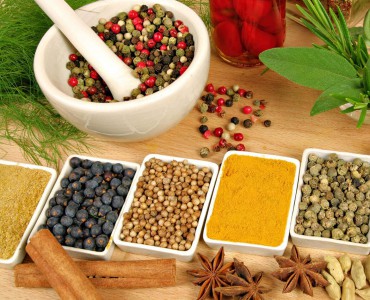Indian cuisine is renowned for its vibrant flavors, and at the heart of this culinary marvel are the spices that bring depth and complexity to each dish. The art of using spices in Indian cooking is not just about adding flavor; it’s about creating a harmonious balance of taste, aroma, and texture. In this article, we’ll explore the rich world of Indian spices, their unique qualities, and their significance in the culinary traditions of India.
The Role of Spices in Indian Cuisine
Spices are fundamental to Indian cooking, transforming ordinary ingredients into extraordinary dishes. They can be used to enhance, balance, or completely change the flavor profile of a dish. In India, spices are often used in combinations, known as masalas, which can vary widely across regions and even households. This blend of spices creates the signature taste of Indian cuisine.
Popular Indian Spices and Their Unique Qualities
1. Turmeric (Haldi)
Unique Qualities: Turmeric is celebrated for its bright yellow color, thanks to its active compound, curcumin. Beyond its role in adding color, turmeric is known for its anti-inflammatory and antioxidant properties.
Flavors: It imparts an earthy, slightly bitter flavor with subtle warmth, making it a staple in curries, rice dishes, and soups.
2. Cumin (Jeera)
Unique Qualities: Cumin seeds have a nutty, warm aroma that becomes more pronounced when toasted. They aid in digestion and add a distinctive flavor to many dishes.
Flavors: Cumin provides a warm, earthy flavor with a touch of citrus, making it essential in spice blends and various curries.
3. Coriander (Dhania)
Unique Qualities: Coriander seeds have a light, citrusy flavor and are used both whole and ground. They are known for their digestive benefits and ability to balance spicy flavors.
Flavors: Coriander adds a mild sweetness and freshness to dishes, making it versatile in curries, chutneys, and pickles.
4. Cardamom (Elaichi)
Unique Qualities: Cardamom pods contain essential oils that give them a potent aroma and flavor. They are used for their digestive and breath-freshening properties.
Flavors: Cardamom offers a sweet, spicy, and slightly floral flavor, making it a key ingredient in both savory dishes and sweets.
5. Cloves (Laung)
Unique Qualities: Cloves are the dried flower buds of the clove tree and are known for their intense aroma and flavor. They are used sparingly due to their strong taste and are valued for their antiseptic properties.
Flavors: Cloves impart a warm, sweet, and slightly bitter flavor with a hint of pepperiness, enhancing rice dishes, stews, and spice blends.
6. Mustard Seeds (Sarson)
Unique Qualities: Mustard seeds come in yellow, brown, and black varieties, each with a distinct flavor profile. They are known for their ability to release a pungent, nutty flavor when heated.
Flavors: The flavor of mustard seeds ranges from mild and tangy to hot and sharp, making them ideal for tempering and pickling.
7. Fennel Seeds (Saunf)
Unique Qualities: Fennel seeds have a sweet, licorice-like flavor and are used for their digestive benefits and unique taste.
Flavors: Their sweet and aromatic flavor balances spicy dishes and adds a refreshing note to salads and desserts.
8. Fenugreek (Methi)
Unique Qualities: Fenugreek seeds have a slightly bitter taste and are used for their medicinal properties and ability to enhance the flavor of dishes.
Flavors: Fenugreek provides a bittersweet and nutty flavor, which adds depth to spice blends, pickles, and lentil dishes.
9. Cinnamon (Dalchini)
Unique Qualities: Cinnamon is known for its sweet, warm flavor and is used in both sweet and savory dishes. It comes from the inner bark of cinnamon trees.
Flavors: Cinnamon adds a sweet, woody flavor to curries, rice dishes, and desserts, often used in combination with other spices.
10. Black Pepper (Kali Mirch)
Unique Qualities: Black pepper is known for its pungent, spicy heat and is often referred to as the "king of spices." It is widely used for its ability to enhance the flavor of nearly any dish.
Flavors: Black pepper adds a sharp, spicy heat and is used in various dishes, from curries to soups, to add a touch of heat and depth.
The Art of Combining Spices
Indian cuisine often features spice blends, or masalas, which are crafted to achieve a balanced flavor profile. Some famous spice blends include:
- Garam Masala: A warm, aromatic blend typically including cardamom, cloves, cinnamon, and cumin. It’s used at the end of cooking to add depth and complexity.
- Chaat Masala: A tangy and spicy blend that includes ingredients like amchur (dried mango powder), cumin, and coriander, commonly used in street food dishes.
- Panch Phoran: A five-spice blend from Bengal, including cumin, mustard seeds, fennel seeds, fenugreek seeds, and nigella seeds, used for tempering.
Health Benefits of Indian Spices
Beyond their culinary uses, many Indian spices offer health benefits. For example:
- Turmeric has anti-inflammatory and antioxidant properties.
- Cumin aids digestion and supports immune function.
- Cinnamon helps regulate blood sugar levels.
- Fennel seeds promote digestive health and freshen breath.
Incorporating Indian Spices into Your Cooking
To make the most of Indian spices, consider these tips:
- Start with Fresh Spices: Whole spices retain their flavor longer than ground spices. Toasting them before use can further enhance their aroma and taste.
- Experiment with Spice Blends: Try creating your own masalas or using pre-made blends to explore different flavor profiles.
- Balance Flavors: Use spices to balance flavors in your dishes. Combine spices to create depth and complexity.
Conclusion
Indian spices are the heart and soul of Indian cuisine, offering a rich tapestry of flavors, aromas, and health benefits. From the earthy warmth of turmeric to the pungent heat of black pepper, each spice brings its own unique qualities to the table. By understanding and experimenting with these spices, you can create authentic Indian dishes and enjoy a culinary experience that is both flavorful and nourishing.


